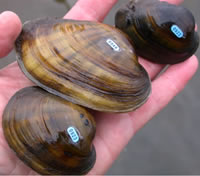Lampsilis higginsii facts for kids
Quick facts for kids Lampsilis higginsii |
|
|---|---|
 |
|
| Conservation status | |
| Scientific classification | |
| Genus: |
Lampsilis
|
| Species: |
higginsii
|
| Synonyms | |
|
Unio higginsii Lea, 1857 |
|
Lampsilis higginsii is a rare type of freshwater mussel often called Higgins' eye pearly mussel or simply Higgins' eye. It lives only in the United States. You can find it in the upper Mississippi River and some of the smaller rivers that flow into it. This mussel is in danger because of an invasive animal called the zebra mussel (Dreissena polymorpha). The Higgins' eye mussel is a federally listed endangered species, meaning it's protected by law.
Contents
What is the Higgins' Eye Mussel?
This bivalve mollusc is a type of river mussel, part of the Unionidae family. It has a thick, heavy shell that looks oval. The shell is usually yellowish or brown, and sometimes you can see greenish lines on it. It can grow up to about 10 centimeters (around 4 inches) long. The inside of the shell, called the nacre, is white. It might have a pink tint and can look shiny, like a rainbow.
Why is the Higgins' Eye Mussel in Danger?
Long ago, this mussel lived in a large part of the Mississippi River, stretching about 850 kilometers (over 500 miles). It also lived in nine rivers that flow into the Mississippi. Today, you can only find it in a smaller part of the Mississippi, from La Crosse, Wisconsin, to Muscatine, Iowa. It also lives in two connecting rivers: the St. Croix and Wisconsin Rivers.
The Higgins' eye mussel has always been rare. But after 1965, its numbers dropped a lot. It lost more than half of the places where it used to live.
Threats to the Mussel
One big reason for the drop in numbers was pollution. For example, the mussel completely disappeared from the Illinois River because of pollution. Its home has also changed because of things like dams and locks on the rivers. Sedimentation, which is when dirt and sand build up, might also have hurt the mussels. Even too much fishing for other animals might have reduced their population.
Today, the biggest threat is the invasive species called the zebra mussel. Zebra mussels are not native to these rivers. They attach themselves to the shells of Higgins' eye mussels and other native mussels. This makes it hard for the native mussels to move or even eat. Zebra mussels can also use up all the food in the water and reduce the oxygen. They might even eat the native mussels' babies (called larvae) and sperm, stopping them from having more mussels. Their waste also makes the water quality worse.
Other invasive species also cause problems. The Asian clam (Corbicula fluminea) competes with the Higgins' eye mussel for food. It can also eat the native mussel's sperm, larvae, and young mussels. Some fish that are not native to the area might also eat young Higgins' eye mussels.
To help the Higgins' eye mussel, scientists have raised them in special facilities. Then, they release these mussels into rivers where they used to live but had disappeared.
Life Cycle and Reproduction
When it's time to have babies, the male mussel releases tiny sperm into the water. The female mussel then takes in the sperm through her siphon. She keeps the fertilized eggs inside her gills until they hatch.
When the eggs hatch, they become tiny mussel larvae called glochidia. These glochidia are then released into the water. To grow, they need to attach themselves to a host animal, which is usually a fish. The glochidia live on the fish for a short time.
Some fish that host the Higgins' eye mussel larvae include:
- Largemouth bass (Micropterus salmoides)
- Smallmouth bass (M. dolomieu)
- Walleye (Sander vitreus)
- Yellow perch (Perca flavescens)
After a while, the glochidia drop off the fish and grow into young mussels on the riverbed.
See also
 In Spanish: Lampsilis higginsii para niños
In Spanish: Lampsilis higginsii para niños


